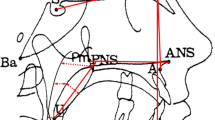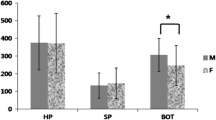Abstract
The study was conducted to find out the association of various naso-oro-pharyngeal structures with sleep macro-architecture in suspected obstructive sleep apnea subjects. Study included 51 subjects with suspected obstructive sleep apnea. Subjects with possible central apnea and those consuming any substance that can affect sleep architecture were excluded. Level I polysomnography was performed after thorough physical examination. Overnight study was scored in 30 s epochs to find out the polysomnographic variables. Surgical treatment was offered wherever indicated. Subjects with moderate to severe obstructive sleep apnea were manually titrated on CPAP with the polysomnogram. SPSS v 17.0 was used for statistical analysis. We did not find any difference in the sleep architecture between genders. Sleep Efficiency was better in subjects with dental overjet, dental attrition, high tongue base, macroglossia, lesser oral cavity volume, edematous uvula, increased submental fat, hypertrophied facial muscles and Mallampatti grade III–IV. Shorter Sleep Latency was seen in subjects with tender TMJ and Mallampatti Gr III–IV. REM latency was shorter in subjects with high tongue base, macroglossia and hypertrophied muscles of mastication. Increased REM was observed in subjects with high tongue base, edematous uvula and tender TMJ. Enlarged tonsils had reversed effect with poor sleep efficiency, increased REM latency and decreased REM. CPAP therapy (N = 20) lessened awake time, decreased N2 and increased REM. Oro-pharyngeal structures affect the sleep architecture in suspected OSA subjects. Nasal structures do not affect the sleep architecture in these subjects and enlarged tonsils have opposite effect. Sleep architecture changes on the titration night with CPAP.

Similar content being viewed by others
References
Kohler Bloch KE, Stardling JR (2007) The role of nose in pathogenesis of obstructive sleep apnea and snoring. Eur Respi J 30:1208–1215
Bausmer U, Gouveris H, Selivanova O, Goepel B, Mann W (2010) Correlation of the epworth sleepiness scale with respiratory sleep parameters in patients with sleep-related breathing disorders and upper airway pathology. Eur Arch Otorhinolaryngol 267:1645–1648
Zonato AI, Martinho FL, Bittencourt LR, de Oliveira Camponês BrasilO, Gregório LC, Tufik S (2005) Head and neck physical examination: comparison between nonapneic and obstructive sleep apnea patients. Laryngoscope 115:1030–1034
Brown DL, Bapuraj JR, Mukherji SK, Chervin RD, Concannon M, Helman JI, Lisabeth LD (2010) MRI of the pharynx in ischemic stroke patients with and without obstructive sleep apnea. Sleep Med 11:540–544
Wong ML, Sandham A, Ang PK, Wong DC, Tan WC, Huggare J (2005) Craniofacial morphology, head posture, and nasal respiratory resistance in obstructive sleep apnoea: an inter-ethnic comparison. Eur J Orthod 27:91–97
Vagiakis E, Kapsimalis F, Lagogianni I, Perraki H, Minaritzoglou A, Alexandropoulou K, Roussos C, Kryger M (2006) Gender differences on polysomnographic findings in Greek subjects with obstructive sleep apnea syndrome. Sleep Med 7:424–430
Lim LL, Tham KW, Fook-Choong SMC (2008) Obstructive sleep apnea in Singapore: polysomnographic data from a tertiary sleep disorder unit. Ann Acad Med Singapore 37:629–636
Virkkula P, Bachour A, Hytönen M, Salmi T, Malmberg H, Hurmerinta K, Maasilta P (2006) Snoring is not relieved by nasal surgery despite improvement in nasal resistance. Chest 129:81–87
Zhang XW, Li Y, Zhou F, Guo CK, Huang ZT (2007) Comparison of polygraphic parameters in children with adenotonsillar hypertrophy with vs without obstructive sleep apnea. Arch Otolaryngol Head Neck Surg 133:122–126
Nixon GM, Kermack AS, McGregor CD, Davis GM, Manoukian JJ, Brown KA, Brouillette RT (2005) Sleep and breathing on the first night after adenotonsillectomy for obstructive sleep apnea. Pediatr Pulmonol 39:332–338
McLean HA, Urton AM, Driver HS, Tan AK, Day AG, Munt PW, Fitzpatrick MF (2005) Effect of treating severe nasal obstruction on the severity of obstructive sleep apnoea. Eur Respir J 25:521–527
Iber C, Ancoli-Israel S, Chesson A, Quan SF, American Academy of Sleep Medicine (2007) The AASM manual for the scoring of sleep and associated events: rules, terminology and technical specifications, 1st Ed edn. American Academy of Sleep Medicine, Westchester
Kushida CA, Chediak A, Berry RB, Brown LK, Gozal D, Iber C, Parthasarathy S, Quan SF, Rowley JA, Positive Airway Pressure Titration Task Force, American Academy of Sleep Medicine (2008) Clinical guidelines for the manual titration of positive airway pressure in patients with obstructive sleep apnea. J Clin Sleep Med 4:157–171
Bianchi MT, Cash SS, Mietus J, Peng C-K, Thomas R (2010) Obstructive sleep apnea alters sleep stage transition dynamics. PLoS ONE 5(6):e11356
Zhang XW, Li Y, Zhou F, Guo CK, Huang ZT (2007) Association of body position with sleep architecture and respiratory disturbances in children with obstructive sleep apnea. Acta Otolaryngol 127:1316–1321
Polotsky VY, Rubin AE, Balbir A, Dean T, Smith PL, Schwartz AR, O’Donnell CP (2006) Intermittent hypoxia causes REM sleep deficits and decreases EEG delta power in NREM sleep in the C57BL/6 J mouse. Sleep Med 7:7–16
Guilleminault C, Lopes MC, Hagen CC, da Rosa A (2007) The cyclic alternating pattern demonstrates increased sleep instability and correlates with fatigue and sleepiness in adults with upper airway resistance syndrome. Sleep 30:641–647
Bardwell WA, Moore P, Ancoli-Israel S, Dimsdale JE (2000) Does obstructive sleep apnea confound sleep architecture findings in subjects with depressive symptoms? Biol Psychiatry 48:1001–1009
Selwa LM, Marzec ML, Chervin RD, Weatherwax KJ, Vaughn BV, Foldvary-Schaefer N, Wang L, Song Y, Malow BA (2008) Sleep staging and respiratory events in refractory epilepsy patients: is there a first night effect? Epilepsia. 49:2063–2068
Hutchison KN, Song Y, Wang L, Malow BA (2008) Analysis of sleep parameters in patients with obstructive sleep apnea studied in a hospital vs. a hotel-based sleep center. J Clin Sleep Med 4:119–122
Tamaki M, Nittono H, Hayashi M, Hori T (2005) Examination of the first-night effect during the sleep-onset period. Sleep 28:195–202
Bruyneel M, Sanida C, Art G, Libert W, Cuvelier L, Paesmans M, Sergysels R, Ninane V (2010) Sleep efficiency during sleep studies: results of a prospective study comparing home-based and in-hospital polysomnography. J Sleep Res 20(1 Pt 2):201–206 PMID: 20561176
Ghoshal AG, Sarkar S, Roy DJ, Das RK, Ray M (2010) Polysomnographic profile in a sleep laboratory in Kolkata: a retrospective analysis of 714 cases. J Assoc Physicians India. 58:415–419
Skaer TL, Sclar DA (2010) Economic implications of sleep disorders. Pharmacoeconomics. 28:1015–1023
Ben-Israel N, Zigel Y, Tal A, Segev Y, Tarasiuk A (2010) Adenotonsillectomy improves slow wave activity in children with obstructive sleep apnoea. Eur Respir J 37:1144–1150 PMID: 20817710
Zhang XW, Zhou F, Li Y, Huang ZT, Wang ZL (2006) Sleep architecture in children with adenoidal hypertrophy. J Paediatr Child Health 42:625–629
Ramos RT, da Cunha Daltro CH, Gregório PB, de Freitas Souza LS, de Andrade NA, de Souza Andrade Filho A, de Souza Machado A Jr (2006) OSAS in children: clinical and polysomnographic respiratory profile. Braz J Otorhinolaryngol. 72:355–361
Bahammam AS, Tate R, Manfreda J, Kryger MH (1999) Upper airway resistance syndrome: effect of nasal dilation, sleep stage, and sleep position. Sleep 22:592–598
Pevernagie D, Hamans E, Van Cauwenberge P, Pauwels R (2000) External nasal dilation reduces snoring in chronic rhinitis patients: a randomized controlled trial. Eur Respir J 15:996–1000
Djupesland PG, Skatvedt O, Borgersen AK (2001) Dichotomous physiological effects of nocturnal external nasal dilation in heavy snorers: the answer to a rhinologic controversy? Am J Rhinol 15:95–103
Li H, Wang PC, Chen YP, Lee LA, Fang TJ, Lin HC (2010) Critical appraisal and meta-analysis of nasal surgery for obstructive sleep apnea. Am J Rhinol Allergy 24:1108–1111 PMID: 21172121
Issa FG, Sullivan CE (1986) The immediate effects of nasal continuous positive airway pressure treatment on sleep patterns in patients with obstructive sleep apnea. Electroencephalogrph Clin Neurophysiology 63:10–17
Aldrich M, Eiser A, Lee M, Shipley JE (1989) Effects of continuous positive airway pressure on phasic events of REM sleep in patients with obstructive sleep apnea. Sleep 12:413–419
Kondo T, Ishii H, Iga T, Nishiya K, Kobayashi I (2005) Changes in sleep architecture by resumption of CPAP in patients with sleep apnea syndrome. Nihon Kokyuki Gakkai Zasshi. 43:578–582
Conflict of interest
None.
Author information
Authors and Affiliations
Corresponding author
Rights and permissions
About this article
Cite this article
Singhal, P., Gupta, R., Sharma, R. et al. Association of Naso-Oro-Pharyngeal Structures with the Sleep Architecture in Suspected Obstructive Sleep Apnea. Indian J Otolaryngol Head Neck Surg 66 (Suppl 1), 81–87 (2014). https://doi.org/10.1007/s12070-011-0326-3
Received:
Accepted:
Published:
Issue Date:
DOI: https://doi.org/10.1007/s12070-011-0326-3




